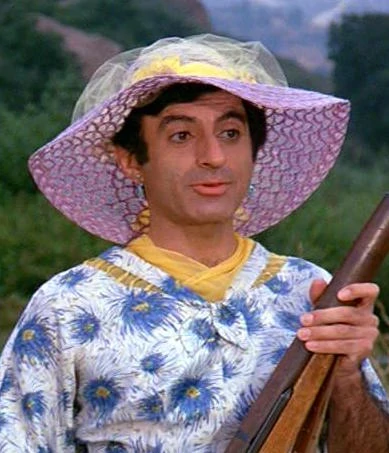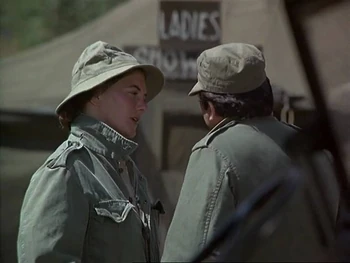A couple of months ago, I listened to a podcast (I thought it was CBC's "Ideas" but apparently not) that discussed the influence of Hawkeye from M*A*S*H on the development of many real-world doctors. The show ran from 1972 to 1983, carrying on for many years after that in reruns, making it a significant part of the somewhat limited media landscape for over twenty years. During that time, late Gen X and early Millennials were soaking up as much TV as they could, avoiding homework and being shaped by their media diets. It didn't surprise me to learn that some of those kids who grew up to be doctors would cite Hawkeye as an inspiration for their medical careers. He is the moral center of the show, after all, a subversive anti-war liberal with charm and relentless wit who was utterly committed to the job of saving lives. Heady stuff for an eleven year-old eating dinner off a TV tray.

It got me thinking about M*A*S*H, though. Being born in 1967, I was right in that sweet spot for growing up with the show. I watched it a lot as a kid and teenager, appealing as it did to my sense of humour and fledgling anti-authoritarianism. Since then, I've grown up to have some pretty lefty politics and I can see the roots of that moral stance nurtured in my impressionable years by the liberal humanism of M*A*S*H. This was also a time that I read Catch-22 and Slaughterhouse-Five, so droll and absurdist anti-war sentiments were becoming a significant part of my developing personality.

It had been decades since I'd last seen the show, but it just so happened that our new Disney Plus membership provided access to the entire run of M*A*S*H. I decided to revisit the show for old times' sake. I dropped in randomly at the beginning of season five, after the introduction of B.J. Hunnicutt and Colonel Potter, and what would be Frank Burns' last season. It didn't take too many episodes before I noticed a number of elements that had resonance with who I am today. There's that liberalism and humour already mentioned, but the comical celebration of booze and drunkenness really stood out to me as a guy in his fourth year of sobriety. Within ten episodes drunk driving was played for laughs twice, with one of those times while Hawkeye and Colonel Potter were under enemy fire. Characters talked about booze, joked about it, embraced it, consumed it, almost fetishized it, and sometimes drank to the point of falling down. For many of the characters on the show, getting drunk was not only entertainment but also a coping mechanism. Of course, I have encountered criticisms of the show before for the drinking and womanizing and realized in retrospect at the time that those were valid takes. But it was something else to actually re-watch the program and experience all that levity around liquor again. It struck a chord.

Less personally relevant to me as a cis-het male but very notable given today's political climate are the issues around Klinger and gender identity. The way the show treats Klinger's attempts to get a Section 8 and be discharged for being crazy by wearing women's clothes is complicated and arguably progressive. While the time period and military context demanded that a man wearing women's clothes is mentally ill, all of the sympathetic characters in the show treat Klinger's wardrobe as routine and accepted, and Klinger himself is a very sympathetic character. It's understood within the show that his cross-dressing is only a gimmick (one of many) to get him discharged, not a reflection of transgenderism. There are some wrinkles here, though. In one episode, Klinger visits regular recurring character Sidney the psychiatrist to confess he's worried that he really is going crazy because of how important his female wardrobe has become to him; Sidney assures him that he is not crazy, however. There is also an episode in Season 7 in which a visiting Swedish female surgeon, Dr. Inga Halvorsen, brings up gender reassignment surgery with Klinger who, as I recall, refuses with some vigour (I have yet to re-watch this episode). The point is that Klinger is never shamed by any of the sympathetic characters and it seems that the main butt of the joke is the intolerance of the Army and, perhaps, society at large. Please see this short article for some ruminations on the matter by someone more qualified than me.
Less meaningful, perhaps, but still interesting to me given what I've been spending so much time working on this last year, is the presence on the show of Hawaiian shirts and bucket hats. Both of those articles of clothing have been in my catalog from the very beginning, and seeing them repeatedly make appearances in what was, for me, such a foundational program gave me little pause, a "Hm..." moment.
For Hawkeye, Trapper, and BJ, Hawaiian shirts are a kind of comfortable protest garment, a flamboyant and relaxed way to be out of uniform. They are a way of saying, "I don't respect the rules that say I have to behave a certain way, and I'm going to demonstrate that as ostentatiously as possible." Hawkeye's blue and white Aloha-style shirt is iconic enough that it can be bought online at a few places and is also cataloged in the Smithsonian.

Henry Blake's fishing hat is also iconic, worn by the reluctant Commanding Officer for his three seasons on the show. It's a bucket hat, although a quite short brimmed one, and I've read one online opinion that it is a grey civilian hat that has changed colour a bit because "it's dirty." Aside from Henry's added bling, it does feel a bit different from the other bucket hats that appear on the show. Henry's hat has a flat crown, while all of the other bucket hats that are used as wardrobe have a more rounded crown.
I certainly noticed LT Col Blake's fishing cap when I first watched M*A*S*H many years ago, but I think I'm safe in saying that the show's other bucket hats left no impression on me at the time. They are almost definitionally a nondescript piece of kit with an emphasis on utility. That utility though, their functionality and convenience, are a big part of what makes the bucket hat so attractive to me.
I will keep watching M*A*S*H over the next while and keep tabs on these themes. Part of Recovery in AA involves a lot of past life review; it's important to understand how the disease developed and use that information help arm yourself against patterns of thought and behaviour that might lead you down that road again. One thing that caught me off-guard during this recent re-watch was how often the show triggered strong and nostalgia-drenched emotion in me. Definitely worth paying attention to.





























Comments